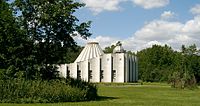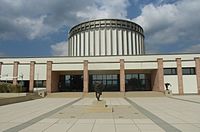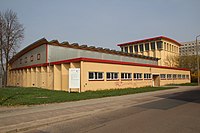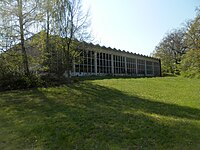Herbert Müller (architect)
Herbert Müller (born February 28, 1920 in Halle an der Saale ; † 1995 ibid) was a German civil engineer and architect who became known for his buildings with hyperbolic-parabolic precast concrete shells . He himself called them " HP bowls ". Müller played a major role in the development of the Halle-Neustadt district , in which the latest building designs in the GDR were used on the initiative of Horst Sindermann, the SED district manager at the time. Architectural historians consider Müller's buildings to be post-war modernism .
life and work
Herbert Müller grew up as the son of a wealthy miller in Döllnitz in the Elster-Saale-Aue . As a teenager he was enthusiastic about gliding and was trained and used as a Stuka pilot during World War II . After the end of the war, Müller studied civil engineering and architecture. He then became the technical director of the housing combine (WBK) Halle.
In 1954, Müller applied for a patent for his development of the “precast reinforced concrete element as an arch element” as a double-curved hyperboloid surface . Müller had competition from West Germany, where in 1956 the Essen civil engineer Wilhelm Silberkuhl registered his patent for “roof construction made of curved shells, especially double-curved reinforced concrete shells”. It became a household name in the field under the name “Silberkuhl Shell” or “System Silberkuhl”. In both shell types, the prestressing steel was prestressed in a tension bed. In 1961 there was a patent dispute in which Müller waived his German patent in exchange for a settlement of 10,000 West Marks. Only then did the GDR building academy give up its resistance to Müller's innovations and his patent, registered in 1954, was approved on April 7, 1961.
The advantage of Müller's construction elements was the “increased buckling and bending stiffness ”, which also resulted in a very desirable saving in material. In addition to the material reduction, the low weight and high load capacity were beneficial. The prefabricated parts could still be manufactured economically even with large spans and erected on the construction site with one or two simple derrick cranes . By variably arranging these half-shell-shaped components in a row, Müller was able to create undulating walls and roofs. These building waves create a loosening contrast to the surrounding block buildings.
"The HP shells in particular now seemed to radiate a kind of lightness of being, they were like a counterpoint to the rigidity and straight lines of the apartment blocks."
Its roof-covering half-tubes have a slight longitudinal curvature like the former school gym at the Halle-Neustadt stadium (see picture). This double curvature of the components is called a hyperbolic paraboloid or “ saddle surface ”. In contrast to these individually assembled components, other civil engineers also have connected, double-curved roofs. With a suspension by two edge cable arches, these form a very strong double-curved steel cable network as in the Dorton Arena or with inserted reinforcing steel in the buildings by Ulrich Müther .
In 1964 Müller presented his first shell structure as a waiting pavilion, the so-called butterfly , on the market square of Halle (Saale). His invention shaped the most varied of "Eastern Modern " buildings such as sports halls, department stores, kindergartens, functional buildings, production facilities, bridges, so that he was soon popularly known as the "bowl miller". The Bad Frankenhausen Panorama Museum was best known for the peasant war panorama , the Sigmund Jähn space flight planetarium in Halle (Saale) and the Delta kindergartens, circular buildings with a radially arranged wave roof.
With the Uni-HP system , Müller developed a modular system of prefabricated shell parts that was used nationwide, especially in sports and swimming pools. Some of his sports halls were classified as a reuse project and therefore built in large numbers, such as the KT 60 HP with around 300 units and the MT 90 HP with around 150 objects.
In 1968 Herbert Müller was awarded the National Prize III. Class for science and technology honored for its share in the exemplary achievements in the development and production of industrially prefabricated hyperbolic precast concrete shells . He also received the State Honored Inventor Award .
The former public swimming pool in Lankow in Schwerin was partially listed as a historical monument at the beginning of its demolition in 2015 and was finally renovated and converted into a residential building ( existing construction ). The Sigmund Jähn spaceflight planetarium, on the other hand, fell victim to the lack of interest from the city council and authorities and was therefore demolished at the end of 2017.
Herbert Müller was buried in the Kröllwitz cemetery in Halle . He left several sons, including the photographer Knut Mueller . With exhibitions, lectures and the handover of his legacy to the Halle city archive, Knut Mueller draws attention to his father's life's work and makes it known to the public.
Work show
Space flight planetarium "Sigmund Jähn" , Halle an der Saale on the Peißnitzinsel (demolished in 2018)
Panorama Museum Bad Frankenhausen with entrance building
School gym at the stadium, today the state performance center for rhythmic gymnastics , Halle-Neustadt
Pavilion on Petersberg near Halle (1965)
Large sports hall at the education center, Halle-Neustadt (1967)
Exhibitions
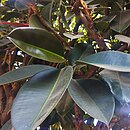
- 2014: From rubber tree leaf to world standard: HP shell construction in Halle-Neustadt as a pioneer of Eastern Modernism in the Halle City Museum , July 13th - November 2nd, 2014.
- 2015: From rubber tree leaf to world class in the Schweriner Höfe, Schwerin , September 9, 2015 to September 30, 2015.
literature
- Herbert Müller: The HP shell construction in its previous application. In: Deutsche Architektur , 1966, vol. 15, issue 2, pp. 83–91.
- Herbert Müller: The Uni-HP system. In: Deutsche Architektur , 1969, vol. 18, issue 10, pp. 631–633.
- Knut Mueller : From rubber tree leaf to "world class". HP shell construction in Halle-Neustadt as a pioneer of the East Modern. In: Peer Pasternack (ed.), 50 years of dispute in Halle-Neustadt. Idea and experiment. Place of life and provocation. Mitteldeutscher Verlag, Halle (Saale) 2014, ISBN 978-3-95462-287-0 , pp. 170–173, full text online , (PDF; 15.1 MB), introduction by the University of Halle .
Web links
- Steffen Könau: Neustadt co-builder Herbert Müller. GDR national prize for “Schalen-Müller” patent. ( Memento of March 7, 2016 in the Internet Archive ). In: Mitteldeutsche Zeitung , July 21, 2014.
- Martin Schramme: "Schalen-Müller": Son reminds of inventors. ( Memento from July 12, 2015 in the web archive archive.today ). In: SonntagsNachrichten - Hallescher Kurier , July 26, 2014.
- Tanja Scheffler: Double Curved | The HP bowls from Herbert Müller. In: Bauwelt , 2014, No. 3, (PDF; 458 kB), full text.
Individual evidence
- ↑ a b c Halle (Saale) city archive: Herbert Müller. In: Facebook , February 28, 2020, accessed May 30, 2020, with photo gallery.
- ↑ a b c d Steffen Könau: Neustadt co-builder Herbert Müller. ( Memento of March 29, 2016 in the Internet Archive ). In: Mitteldeutsche Zeitung , July 21, 2014, p. 2.
- ↑ a b Tanja Scheffler: A space flight planetarium in transition. In: ModerneREGIONAL , July 12, 2015.
- ^ NN : Knut Mueller: In conversation with the son of Schalenmüller. In: hallespektrum.de , December 11, 2014.
- ↑ Klaus Stiglat: Wilhelm Silberkuhl in. Idem, civil engineers and their work , Serious, Berlin 2004, ISBN 978-3-433-01665-7 , S. 394th
- ↑ Roof construction made of curved shells. In: google.de/patents .
- ↑ Tanja Scheffler: Double Curved. The HP bowls from Herbert Müller. In: Bauwelt , 2014, No. 3, (PDF; 458 kB).
- ↑ Herbert Müller ('Schalenmüller') and the HP shell construction • Lectures. ( Memento of March 4, 2016 in the Internet Archive ). In: hallelife.de , June 2015.
- ↑ Martin Schramme: 1964, November 22nd. In: händelstadt-halle.de , accessed on September 7, 2016.
- ↑ a b Tanja Scheffler: The civil engineer Herbert Müller ("Schalenmüller") and his concrete structures. In: 14th workshop discussion on the history of GDR planning January 21-22, 2016 , ed. from the Leibniz Institute for Spatial Social Research (IRS), p. 13 f., (PDF; 654 kB).
- ^ Steffen Könau: Neustadt co-builder Herbert Müller. GDR national prize for “Schalen-Müller” patent. ( Memento of March 7, 2016 in the Internet Archive ). In: Mitteldeutsche Zeitung , July 21, 2014, p. 1.
- ↑ Photo: "Sindermann" butterfly. In: Flickr , accessed May 27, 2020.
- ↑ The construction. In: Panoramamuseum Bad Frankenhausen , accessed on May 27, 2020.
- ↑ Photo: Delta Kindergarten 1968. In: haneu-bildarchiv.de , accessed on May 27, 2020.
- ↑ cf. List of the winners of the National Prize of the GDR III. Science and Technology Class (1960–1969) # 1968
- ↑ Grit Büttner: Living in the people's swimming pool - the monument is being rebuilt. In: Leipziger Volkszeitung , October 31, 2016.
- ↑ Steffen Könau: Planetarium • Demolition of the globally unique building was a misunderstanding. ( Memento from January 24, 2018 in the Internet Archive ). In: Mitteldeutsche Zeitung , January 24, 2018.
- ^ Forum: Demolition of the planetarium - all just a misunderstanding. In: hallespektrum.de , 7. – 12. May 2018.
- ↑ Forum topic: Who was Herbert Müller? In: hallespektrum.de , August 15, 2012.
- ↑ Lecture: Wismar DIAlog | Knut Mueller. In: Faculty of Design at the University of Wismar , September 28, 2016.
- ↑ Steffen Könau: The monument stormers . Worldwide unique planetarium in Halle before demolition. In: Mitteldeutsche Zeitung , December 22, 2017: "A few days ago the gutting of the building began to create space for the excavators." (Only the beginning of the article free, introduction. )
- ↑ From rubber tree leaf to world level. ( Memento from September 15, 2016 in the Internet Archive ). In: kunstplattform-halle.de .
- ↑ stm: Exhibition on the construction of the Lankow swimming pool opened. ( Memento from September 25, 2016 in the web archive archive.today ). In: Schwerin-lokal.de , September 2015.
| personal data | |
|---|---|
| SURNAME | Müller, Herbert |
| ALTERNATIVE NAMES | Schalenmüller (vernacular) |
| BRIEF DESCRIPTION | German architect and civil engineer |
| DATE OF BIRTH | February 28, 1920 |
| PLACE OF BIRTH | Halle on the Saale |
| DATE OF DEATH | 1995 |
| Place of death | Halle on the Saale |

